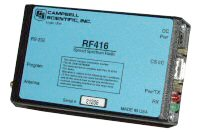
概览
RF416 射频电台的操作频段是2.450 到 2.482 GHz,适用于世界上的很多国家。RF416的功率只有50 mW,可发送数据到另一个RF416 电台、RF432 电台、CR216(X) 数据采集器或AVW216 振弦接口。
RF411 支持 点-点 或 点-多点 的通讯方式。当连接到数据采集器时,RF416可作为野外modem/电台;当连接到计算机时,可作为基站modem/电台。这种电台还可以作为独立工作的射频 路由器/转发器。
优势与特点
- Long range, wireless communications between devices
- Hassle-free operation in many countries where license-free operation is allowed
- Low average power consumption
- Optimized for Campbell Scientific PakBus networking
- Improved RF efficiency when using PakBus protocol compared to other third-party solutions
- Low-cost, stand-alone operation when a dedicated PakBus RF repeater is needed
- Frequency hops over 25 channels avoid interference from other spread-spectrum radios
图像

技术说明
通过提供用户可选择的频段跳频模式,RF416减小了来自其它射频设备的无线电干扰的敏感性。射频电台在相对宽波段的频带上,传播正常的窄波段信息讯号。这种处理方法使得通讯噪声更低,和更不易受无线电源的干扰,例如寻呼机和蜂窝电话。
产品规格
| Frequency | 2.450 to 2.482 GHz |
| Radio Type | Frequency Hopping Spread Spectrum (FHSS) |
| Country Used In | FCC-certified module for the USA |
| Transmission Distance | 0.4 km (0.25 mi) with omnidirectional antenna (outdoors); up to 0.8 km (0.5 mi) with higher-gain directional antennas at ideal conditions |
| RS-232 Baud Rate | 38.4k, 19.2k, 9600, 4800, or 1200 bps |
| Channel Capacity | 65,000 Network Identifiers share 25 hop channels. |
| Frequency Hopping Patterns | 6 different selectable patterns |
| Frequency Control | Direct FM |
| Receiver Sensitivity | -104 dBm at 10-4 bit error rate (Campbell Scientific protocols will issue retries wherever a bit error occurs.) |
| Interference Rejection | 70 dB (at pager and cellular phone frequencies) |
| Power Output | 50 mW (nominal) |
| Data Rate | 10 kbps |
| Antenna Connector | Reverse Polarity SMA (RPSMA) |
| RS-232 Connector | 9-pin D female (4 wire: Tx, Rx, CTS, GND) |
| CS I/O Connector | 9-pin D male |
| FCC ID | OUR-24XSTREAM |
| Power | 9 to 16 Vdc |
| Operating Temperature Range | -25° to +50°C |
| LEDs | Power on, TX, RX, diagnostics |
| Power Connector | Barrel plug, center positive 12 V (used to connect the 14291 Field Power Cable) |
| Average Current Drain |
|
| Communication Ports |
|
| Dimensions | 11.4 x 7.0 x 2.9 cm (4.5 x 2.8 x 1.1 in.) |
| Weight | 227 g (8 oz) |
兼容性
Please note: The following shows notable compatibility information. It is not a comprehensive list of all compatible products.
Additional Compatibility Information
Communications
Internal Radio of CR216(X) Dataloggers
The RF416 spread spectrum radio can communicate with the internal spread spectrum radio of our CR216(X) dataloggers. Certain RF416 settings must match the CR216(X) settings for communications between the radio and data logger to be successful. The factory default settings of these devices may not match; therefore, they may need to be reconfigured before communications can take place. For more information, refer to the Quick Reference Guide for Setting Up RF401-to-CR206 Communication application note (see Documents on the right).
Other Spread-Spectrum Radios
RF416 radios can be used in networks containing RF432 and RF415 radios. When RF416 radios are used in networks that include RF415 radios, the Protocol must be set to Transparent. Also, If RF415 and RF416 radios will be in the same RF proximity, do not use 28, 44, 52, 56, or 60 for the RF415 Net Address. RF415 radios with Net Addresses of 28, 44, 52, and 56 interfere with RF416 radios with Net Addresses of 0, 1, 2, and 3, respectively. The RF415 Net Address of 60 interferes with all RF416 Net Addresses.
The RF416's 2.4 GHz radio is also a good fit for parallel operation in RF450, 900 MHz networks due to the frequency difference (i.e., 2400 MHz versus 900 MHz).
Campbell Scientific does not recommend using the RF416 in networks containing FGR-115 radios.
Transparent and PakBus Protocols
Do not mix RF416 radios set to the Transparent protocol with RF416 or RF432 radios set to either of the PakBus protocols, since this will produce RF traffic without any RF communications. However radios with the PakBus Aware and PakBus Node settings can coexist in the same network (i.e., some radios set to PakBus Aware and some radios set to PakBus Node).
Enclosure Considerations
A desiccated, non-condensing environment is required. The 14162 Mounting Kit includes hardware for securing the RF416 to an enclosure backplate (see Ordering Info).
下载
RF401 Series OS v.04 (646 KB) 14-08-2008
Current RF401, RF411, RF416 firmware. Requires the Device Configuration Utility.
常见问题解答
RF416: 4
展开全部收起全部
-
The RF416 is a 50 mW, 2.45 to 2.46 GHz radio that requires true line of sight. In a dry environment, with absolutely no physical obstruction to impair the line-of-sight path, and with the proper and elevated antennas, the expected range is approximately 5 miles for the RF416.
-
Antenna selection depends on multiple criteria:
- Consider how many stations a particular station needs to communicate with. For remote stations in communication with only one repeater or base station, a directional or Yagi antenna may be an appropriate choice. In contrast, repeater stations that receive data from many different locations will probably require an omnidirectional antenna.
- Consider if a high-gain antenna is needed to overcome the path between two points. Higher-gain antennas are larger and more expensive.
To help with antenna selection and site placement, consider renting and using a demo kit to test the pathway quality. Campbell Scientific offers a 900 MHz demo kit for the RF401, RF430, CR206X, and AVW206, as well as a demo kit for the RF450. Contact Campbell Scientific for assistance.
